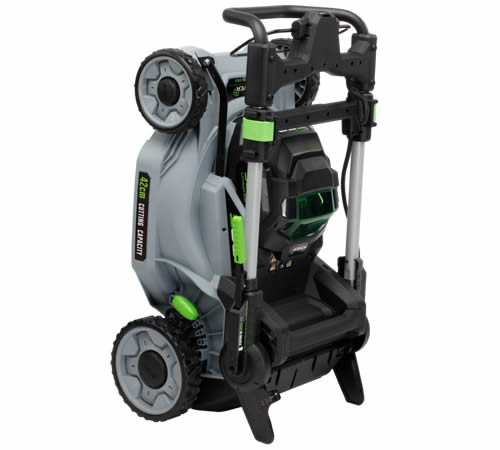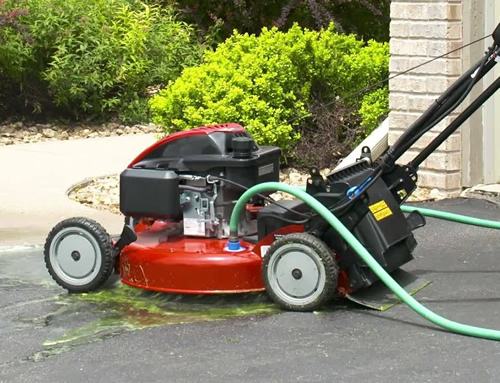
A lawnmower is an investment that would hopefully offer years of faithful service. Annual servicing, blade changes and sharpening increase the product life of a lawnmower as well as keeping the machine mowing at its best. Another important maintenance task is to clean the mower, we have compiled a list of tips for cleaning your walk-behind and ride-on mower.
Thank you for reading this post, don't forget to subscribe!Over 6000 accidents involving lawnmowers are reported each year. Blades, engines and electrical systems can cause injuries and proper preparation before starting any maintenance is imperative. Always consult your mowers manual for the best safety practices.
Making it routine to use a leaf blower or stiff brush to remove loose grass cuttings from deck and underneath the after every use will save you extra effort when performing an intensive clean and protect the mower from premature deterioration. Never use an air compressor to clean your lawn mower, the intense airflow can force dirt into components and crevices.
A thorough clean of your mower is recommended twice per season. The collected grass dries on coating the underneath deck, blades and components. Even the smallest pieces of grass or debris can collect between elements eventually causing the mower to overheat which could lead to possible engine damage.
Never tip your walk behind lawn mower on its side with petrol and oil in, it could cause fuel or oil to flow into other components and cause smoking or starting issues. Always tip it back on its handles, secure it safely at a 45-degree angle allowing enough gap to access the blades. Ride on mowers or lawn tractors are more resilient when working at angles, a small amount of oil may need to be drained if particularly high.
With petrol engines, planning your cleaning around the same time as needing to refuel will save you needing to drain the fuel or run the engine until it’s empty.
Choosing to clean the mower on a sunny day will allow the mower to dry wholly before storing it.
Whilst you are cleaning the lawn mower it is a good time to look for any damage or corrosion that may need addressing.
We recommend wearing goggles, gloves and overalls and working in an open or well-ventilated area with good drainage.
Making sure the mower is disabled and will not start unexpectedly is paramount before commencing any work.
Before starting remove the mower attachments such as the grass bag, mulch plug or side-discharge chute. Clean these separately with a hard brush, warm water or jet hose.
Before starting to clean ensure the petrol mowers are switched off, lithium batteries are removed and electric supplies are disconnected.
It is also important to remember that petrol engines which have battery assisted starting have electrical components that should be protected from water.
Walk behind lawn mowers

Cleaning electric and cordless lawn mowers
With electric and battery-powered mowers you do not need to worry about fuel or oil and can confidently tip them on their side for cleaning. However, never use a wet hose or pressure washer to clean an electric or battery mower. Always make sure batteries and start keys are removed. Disconnect power cords and make sure there isn’t any electrical supply to the mower.
Cordless mowers have either plastic chassis or steel deck. Clean them the same way and take good care not to get water into the electrical components. Using a damp cloth wipe inside the battery housing cleaning away any dust or dirt. Dry with a clean cloth.
The plastic motor housing on electric mowers can be removed for cleaning, consult your manual to check how to do this. It’s recommended to clean this area once a month in the growing season to keep your mower working at its best.
For all-electric and cordless mowers use a hard bristle brush to remove grass and debris from the lawnmower. It is important to make sure the vents are clean and clear. Tip the mower on its side and using the brush remove the grass and dirt from the inside deck and blades, you can use a flat-bladed scraper to remove stubborn dirt taking care not to damage the deck. Wipe the whole mower including the handles and wheels with a damp cloth. Dry thoroughly before storing.
Cleaning petrol lawn mowers

Premium mower decks usually have a hose connector for attaching a hosepipe. For all other mowers, we recommend using a bucket of warm water and a hosepipe. Petrol mowers may be weatherproof, but they are not waterproof. It is important not to get water near the engine or electrical components. Vertical storage mowers stand on the end allowing excellent access to the blades and under the deck. Check out Mow N’Stow and SMARTSTOW® models on our website.
Remove any loose grass and debris from the top of the mower deck using a stiff bristle brush. If there are vents, take care to keep them clean and clear.
Carefully tip the mower back on its handle at 45 degrees and support it securely so it will not fall. Using a stiff brush remove as much of the compacted grass as possible. If there are hardened deposits, you can use a flat-bladed scraper to remove them, taking care not to cause damage to the mower. Use a gentle flow of water to soften and remove the debris from the underneath of the deck and blades, taking great care not to get liquid into vents, components or the engine. Clean the wheel and tyres avoiding the bearings. Wipe with a clean cloth.
Place the mower safety on the ground and thoroughly wipe down the rest of the mower with a damp cloth. Wait until the mower is fully dried before storing it away.
Watch a useful video from Toro on how to clean your petrol lawnmower here
Before starting to clean ensure the engine is switched off and the blades are at a complete stop. The parking brake must be engaged, disconnect the battery, remove the ignition key and unplug the spark plug.
Some small ride on mowers such as the AL-KO Solo and Snapper RER lawn rider can be tipped on end for full access to the under-deck and blades. For the all other ride on mowers or garden tractors using a side lift jack will give enough room to effectively clean.
We recommend Side Lift Jack with 400kg Max Lift – Ride on Mower / Tractor £59.99
Most riding mowers have wash ports or hose connectors. These make it simple to attach a hose and gun to clean the mower. If you do not have a wash port using a pressure washer is the most effective way to remove dry grass and debris.
We recommend Stiga HPS 235R Electric High Pressure Washer £149
Remove as much compacted grass as you can from the top of the deck and underneath using a stiff bristle brush. For particularly stubborn debris spraying the underneath of the mower with a suitable detergent and leaving for 10 minutes should help loosen it making the job easier. Take care not to get any liquid into electrical components or the engine. A flat bladed scraper can be used to remove unyielding debris. Using the jet function on your hose, aim and remove the compacted grass and dirt, aided by a brush if needed. Gently spray and brush the tyres and wheels whilst the deck is lifted avoiding the bearings. When the underneath of the mower is thoroughly cleaned lower the grass tractor safely to the ground. Use the hose to gently clean the rest of the ride on. Brush and clear the bonnet vents. Wipe the seat and dash with a damp cloth. Let the lawn tractor dry completely before storing away.
For cleaning front deck ride-on mowers Stiga have a useful video, watch it here
Final thoughts
A lawnmower should offer years of service, they can certainly be costly when they go wrong. Keeping your machine clean will also validate any warranty, reducing the chances of issues caused by residue debris.
